Before the Goryeo Kingdom (918-1392), from which the name “Korea” comes, the Korean Peninsula was a battleground for three ancient kingdoms -- Goguryeo, Baekje and Silla -- from the first century BC through the seventh century AD.
The Silla Kingdom in the southeast, originating from what is today’s North Gyeongsang Province, was the unifier of the rivalrous kingdoms. Silla conquered Baekje in 660 and Goguryeo in 668, leading to Unified Silla (668-935), where culture, religion and arts flourished through close ties with Tang China.
Gyeongju, a coastal city in the southeast, was the capital of Silla from 57 BC to 918 AD, the year Silla succumbed to Goryeo. The city was the wellspring of the royal court, aristocracy, commerce and culture, and home to nearly 1 million people at its peak, according to Samguk Yusa, a collection of folktales and accounts of the three kingdoms.
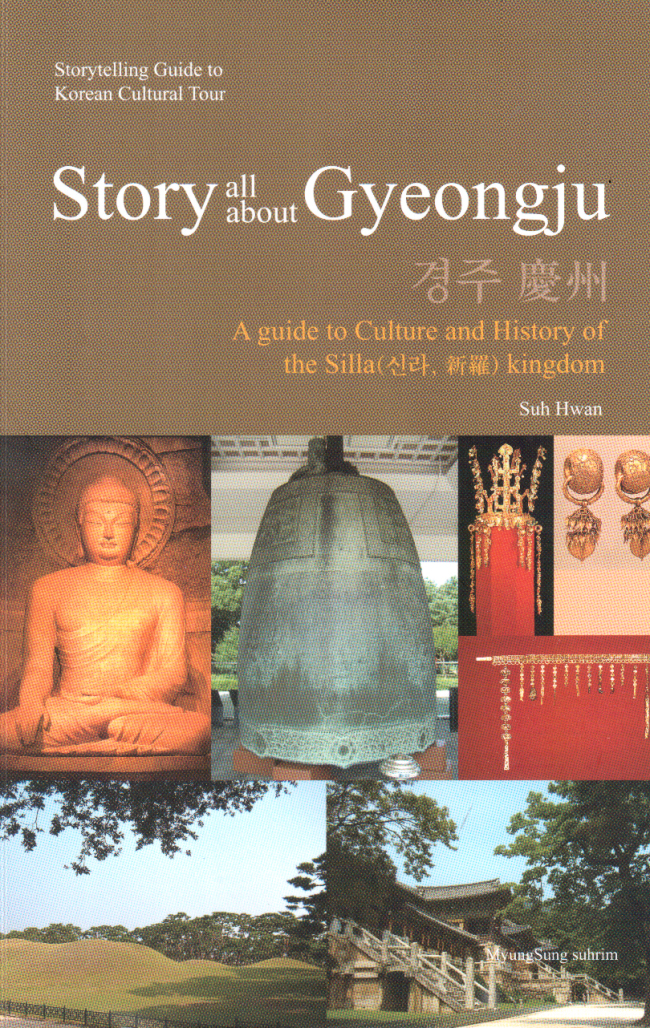 |
“A Story All About Gyeongju: A Guide to the Culture and History of Silla Kingdom” by Suh Hwan; Myungsung Suhrim (303 pages, $15,000 won) |
Korea’s united national identity was formed for the very first time under the Unified Silla. There, Buddhism and Confucianism thrived as the aristocracy’s ruling ideologies, as well as the mainstays of architecture and fine arts.
For Suh Hwan, the author of “A Story All About Gyeongju: A Guide to the Culture and History of Silla Kingdom,” Silla has been a source of lifelong intrigue and inspiration. As the world’s interest in Korea has grown by leaps and bounds, fueled by the country’s economic boom and cultural exports of Hallyu, outsiders curious about Korea’s deep-rooted identity deserve a nuanced look at Silla’s treasures and legacies, he argued in writing the book.
“Through this book, I have tried to add to the body of the latest generation of Korean scholars’ works in history and archaeology. They are acquainted with international sensibilities and equipped with a rational understanding of our cultural properties,” the elderly man told The Korea Herald.
“In my humble opinion, guidebooks on Korea’s tourist attractions should interpret our culture and history with a modern understanding and global perspective, rather than rehashing timeworn legends created thousands of years ago.”
A teenager during the 1950-53 Korean War, Suh worked as an English tour guide for foreign visitors to Korea in the 1970s and outbound tour operator following the 1988 Seoul Summer Olympics.
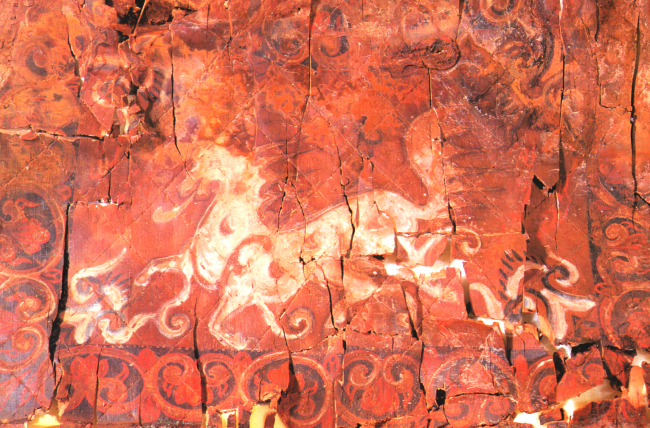 |
Cheonmado painting in Cheonmachong (Cheonmachong) |
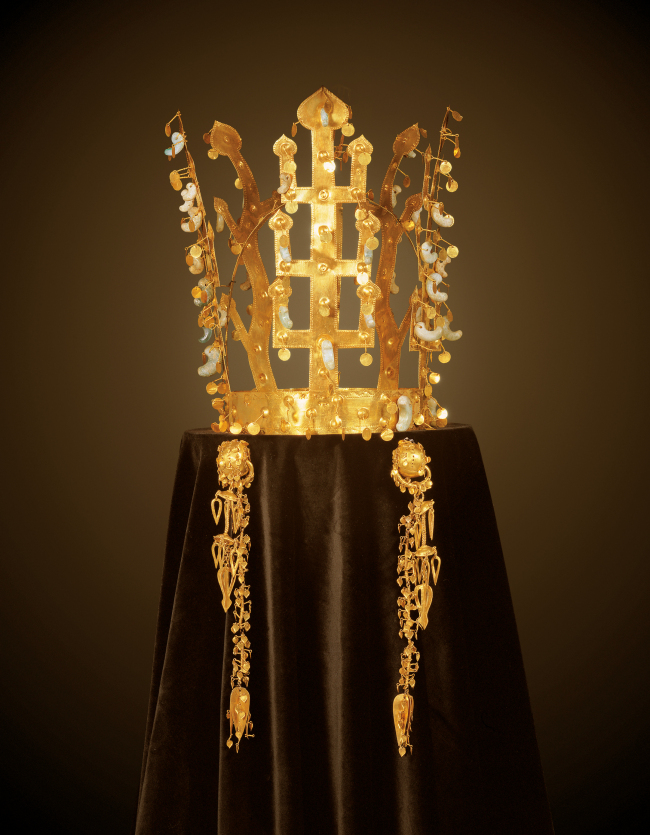 |
The Crown of Silla in Cheonmachong (National Museum of Korea) |
The 303-page book is full of detailed explanations about Silla’s heritage and artifacts -- their locations, historical significance and legends -- all told in a storytelling style with maps, pictures and cartoon illustrations. It has 20 chapters with 100 questions and answers about the kingdom that covered Gyeongju and its outlying areas. The book, a culmination of immense investigation over a year, is strewn with playful insights.
For starters, Suh recommends visiting Cheonmachong, or the “Heavenly Horse Tomb,” in Gyeongju. Excavated in 1973, Cheonmachong was the tomb of an unknown Silla king from the fifth to sixth century. Visitors can see precious objects such as a golden crown, a girdle decorated with jade and pendants and a painting of a heavenly white horse on a birch bark saddle flap.
“You shouldn’t miss walking around Cheomseongdae, which was an astronomical observatory in Gyeongju,” he adds. Cheomseongdae, meaning “star-gazing tower” in Korean, was constructed in the seventh century, and is the oldest surviving astronomical observatory in Asia and possibly the world, according to historians.
“Gyochon Hanok, a village of clustered traditional Korean houses, is another not-to-be-missed spot on your itinerary,” the author says.
Suh advises going to the temple Bulguksa, a UNESCO World Heritage Site and head temple of the Jogye Order of Korean Buddhism, which is also home to the national treasures of the Dabotap and Seokgatap stone pagodas, Cheongun-gyo, or “Blue Cloud Bridge” and two gilt-bronze statues of Buddha. The gem of the temple is Seokguram Grotto, where a Buddha statue 3.5 meters tall and sitting on a lotus pedestal symbolizes enlightenment.
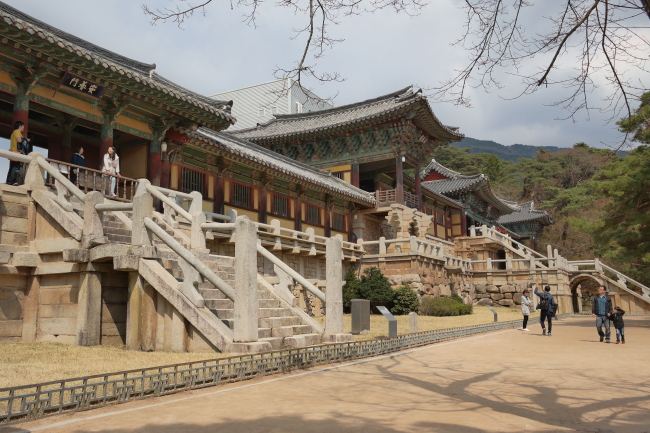 |
Bulguksa in Gyeongju (Visit Korea) |
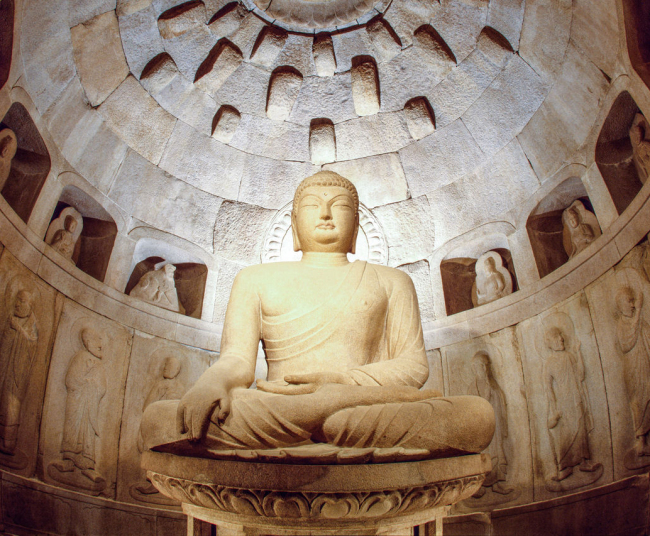 |
A Buddha statue inside Seokguram Grotto (Imagine Your Korea) |
The writer says it is worth paying a visit to the Ulsan Rock Art Museum and temple Tongdosa in Yangsan, as well as the temple Haeinsa in Hapcheon County, the home since 1398 of 81,350 wooden printing blocks with Buddhist scriptures engraved during the early 13th century Mongol invasion.
“Our central and local governments and companies should focus on bringing foreign tourists to areas outside of Seoul, including many historic sites that are laden with treasures,” Suh said, adding the promotion of these areas with creative stories and foreigner-friendly interpretation is needed.
Pointing out that a manuscript from an essay by Silla priest Wonhyo (617-686), titled “Panbiryang-ron,” was discovered from a private collection in Tokyo in April last year, Suh said Gyeongju has the potential to be like Kyoto in terms of depth and breadth of cultural preservation.
“I believe Hallyu should be continuously expanded and cultivated by supporting scholastic efforts of academics and devotees. That is our next step in ensuring Hallyu’s sustainability,” he argued.
By Joel Lee (
joel@heraldcorp.com)












